Understanding the Top Causes of Meningitis and Their Impact on Your Health
Explore the top causes of meningitis, including viral, bacterial, and fungal origins. Learn how each type affects health, symptoms to watch for, and preventive measures to protect yourself from this serious condition. Early recognition and treatment are essential for reducing risks and improving recovery outcomes.

Understanding the Top Causes of Meningitis and Their Impact on Your Health
Meningitis is a serious medical condition characterized by inflammation of the meninges, which are the protective membranes enveloping the brain and spinal cord. This inflammation can result from infections caused by various pathogens, including viruses, bacteria, and fungi, leading to a wide range of symptoms that can vary from mild discomfort to life-threatening emergencies. Recognizing the different causes of meningitis, along with understanding its mechanisms, is crucial for both prevention and effective treatment.
Main Causes of Meningitis and Their Effects
Meningitis can be caused by various infectious agents, but the most common are viruses and bacteria. Fungal infections are rare but can lead to significant health issues, especially in individuals with weakened immune systems. Understanding each of these causes helps in recognizing symptoms early and seeking appropriate medical care.
Viral Meningitis: The Most Common Form
Viral meningitis accounts for the majority of cases worldwide and is generally less severe than bacterial meningitis. It often resolves on its own within a few days to weeks, making it a relatively manageable condition if diagnosed early. Several viruses are known to cause viral meningitis, including herpes simplex virus, mumps virus, human immunodeficiency virus (HIV), and West Nile virus.
This form of meningitis tends to be less contagious, especially when transmitted through vectors like mosquitoes, which spread West Nile virus. While mild in most cases, symptoms such as fever, headache, stiff neck, nausea, and light sensitivity should not be ignored, as they require medical evaluation to confirm diagnosis and manage symptoms effectively.
Bacterial Meningitis: A More Severe Threat
Bacterial meningitis is significantly more aggressive than its viral counterpart. It occurs when bacteria from various sources infiltrate the bloodstream and reach the meninges, causing rapid inflammation. This form of meningitis can escalate quickly, leading to serious complications or death if not treated promptly.
Key bacteria responsible for bacterial meningitis include Streptococcus pneumoniae, Haemophilus influenzae, Neisseria meningitidis (meningococcus), and Listeria monocytogenes. The infection can be triggered by factors such as head injuries, ear infections, sinus problems, or recent surgeries. Recognizing early symptoms like high fever, severe headache, neck stiffness, vomiting, altered mental status, and sensitivity to light is vital for immediate medical intervention.
Fungal Meningitis: A Rare but Serious Condition
Fungal meningitis is an uncommon form that typically affects individuals with compromised immune systems, such as those living with AIDS or undergoing immunosuppressive treatments. It results from infections like Cryptococcal meningitis, which invade the cerebrospinal fluid and cause persistent inflammation.
Unlike viral or bacterial meningitis, fungal meningitis is not contagious but requires specific antifungal medications to control the infection and prevent severe neurological complications. Symptoms may develop gradually over weeks, including headache, fever, neck stiffness, and sometimes neurological deficits.
Chronic Meningitis: Developing Over Time
This form of meningitis develops slowly, often over several weeks or months, caused by slow-growing fungi or bacteria. Its insidious onset can make diagnosis challenging, and the condition often leads to long-term neurological issues if not identified and treated appropriately.
Contagiousness and Transmission of Meningitis
The contagious nature of meningitis varies depending on its type. Most bacterial and viral meningitis strains are transmissible through respiratory droplets, close contact, or sharing personal items. This underscores the importance of stringent hygiene practices, vaccination, and avoiding close contact with infected individuals.
In contrast, fungal and chronic forms are generally not transmissible among people. However, maintaining awareness and practicing preventive measures—such as vaccination and good hygiene—are crucial to reducing the risk of infection.
In summary, understanding the diverse origins of meningitis, including viral, bacterial, fungal, and chronic types, plays a vital role in early detection, treatment, and prevention. If you experience symptoms such as severe headaches, neck stiffness, fever, or neurological changes, seek medical attention immediately. Vaccination, good hygiene practices, and prompt treatment are key strategies to combat this potentially life-threatening condition.





